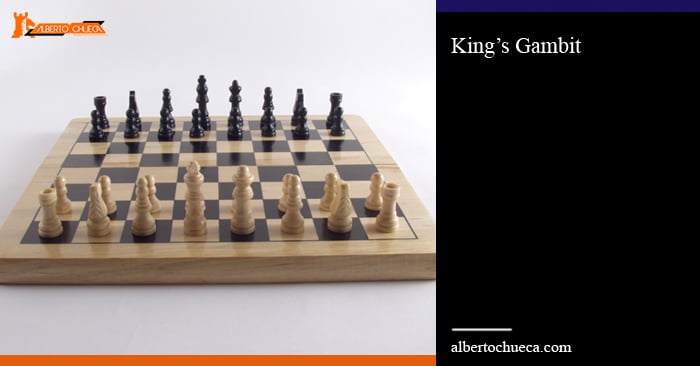King's Gambit
If you like adventures, King’s Gambit is the Opening you need to play as White. In this variation, the first player is sacrificing a pawn in move number two. Usually, the middlegame will be sharp and dynamic. If you are an aggressive player who enjoys open positions, then you are on the right site.
This opening is rarely played among top masters nowadays. However, it is a very interesting option for beginners and club players.
Some theory and ideas in King's Gambit
We have King’s Gambit after the moves
1.e4 e5 2.f4!
The idea of this move is to open the “f” file and also deflect the black central pawn on e5 so White can play d4 anytime soon and control the center with two pawns. If Black accepts the gambit (which is probably the best move for Black) then the extra pawn on f4 will not be particularly well protected, which means that sometimes White can also get the pawn back.
Of course, this move 2.f4 is not perfect: besides losing a pawn, it is weakening the important diagonals g1-a7 and e1-h4 (where white King is at the beginning of the game).
Black has 3 main alternatives here:
a) 2… d5 Falkbeer Counter Gambit
This line is actually interesting for Black. White plays 2.f4, thinking of sacrificing a pawn for some compensation, and in this variation, it will happen the contrary: the first player ends up getting an extra pawn and this time the compensation will be for Black. So, this Counter Gambit could be confusing and shocking for the aggressive King’s Gambit player. Although, the position will be nice for White after the moves:
3.exd5 e4!?
4.d3! Nf6 5.dxe4 Nxe4 6.Nf3 and White is slightly better
b) 2… Bc5 King’s Gambit Declined or Classical Defense
This is another good option. Black is directly controlling the weak diagonal, and now White will not be able to castle so easily. The right plan then will be to play c3 and d4. The second player will try to avoid it. The line continues:
3.Nf3
This move is very logical and important. The Knight is developed so White can castle soon, and also it is controlling h4, which means the Queen cannot go there now and try to take advantage of the weak diagonal.
In this position, a bad move for White (and a typical mistake among beginners) is the tempting 3.fxe5?? Then Black can continue with Qh4+! and this is just winning for Black, because after 4.Ke2 Qxe4# is Checkmate and after 4.g3 also Qxe4+ and the Rook on h1 is hanging.
3… d6 4.c3 Bg4
By pinning the Knight, White is avoiding the move d4 by now. However, White can continue with his plan.
5.Be2 Nc6 6.b4 threatening the Bishop and playing b5 in the next, so the black Knight will have to move out of c6 and d4 should be possible again. The game is more or less balanced (still unclear though).
c) 2… exf4 King’s Gambit Accepted
Most masters say that if Black wants to get something in the opening they need to accept the Gambit. But on the other side, this is exactly what the King’s Gambit player wants :)
3.Nf3 (Once again avoiding Qh4 and wanting to play d4 very soon. Also 3.Bc4, known as Bishop’s Gambit is a common and interesting move in this position)
3… g5
This move looks crazy, but when we analyze it, it makes a lot of sense. The extra pawn on f4 is now very well protected. This pawn means not only a material advantage, but it is also hindering some white pieces, like the dark squares Bishop or the Rook on f1 (when White castles). Besides, the “g” pawn can go to g4 at any point, creating an annoying threat on the Knight. The drawback with the move g5 is the weaknesses created in the Kingside for Black.
4.h4
The idea of this move is to break the connection g5-f4. The Knight will go ahead and will attack f7 along with the Bishop.
4… g4 5.Ne5 Nf6 6.Bc4 d5 7.exd5 Bd6 8.d4 and even when the engines say Black is slightly better, the position is extremely unclear with equal chances for both players.
Typical Plans for White in King's Gambit
We could say Black has two approaches against King’s Gambit: accept or decline the Gambit, although, it has been said that the best way to play as Black is to accept it. Let’s see general ideas:
- Black declines with second moves like Bc5 or d5:
These positions should be sharp, but with similar chances for both players. Black can try to exploit the weakness in the diagonal a7-g1, but very often White can play d4 and get rid of that annoying pressure. Also, if for some reason d4 is not possible, another plan is to play Qe2 and Be3. Even the idea Rf1, definitely not short castling, but putting a lot of pressure on f7 could be interesting in some positions.
- Black accepts the Gambit and plays 2. … exf4
White needs to keep in mind the check on h4 (Qh4+), that’s why the mainline here is Nf3. The first player wants to play d4 very soon, also get the f4 pawn back if possible, and exploit the half-open “f” file with the Rook by castling. Black can avoid it with g5, but this move is also weakening a little Black’s Kingside.
Typical squares for some white pieces in King's Gambit
King: In most of the lines (but not always) White castles Kingside.
Knights: the Kingside Knight goes to f3 almost always, and after Black plays g4 in some lines, it can go aggressively to g5 or e5. There is a dynamic line where White sacrifices this Knight from f3 getting the “g” pawn and a lot of activity over the “f” file.
Bishops: The light squares Bishop goes to c4 almost always putting a lot of pressure on f7 along with the Rook or the Queen over the “f” file.
Rooks: The Kingside Rook will be activated over the “f” file and it should play a significant role in this line.








